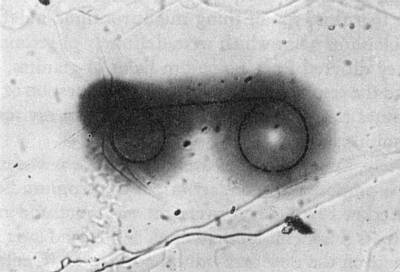|
Earth Science Associates |
|||||||||
|
||||||||||
|
Creation's Tiny Mystery |
||||||||||
|
|
The Spectacle HaloDuring a routine examination of a mica specimen from the Silver Crater Mine near Faraday Township in Ontario, Canada, I discovered a most unusual pattern of 210Po halos. In the more than 100,000 halos which I had examined under the microscope, none had even faintly resembled the connecting circular patterns observed in this "spectacle halo" (a photograph of which is shown in Figure 3.1 and in the Radiohalo Catalogue). Incidentally, the shape of this special halo is completely different from any of the known crystallization patterns, all of which yield minerals with straight edges. No mineral crystallizes in circles; yet for some reason the radiocenters of the "spectacle halo" did. From its appearance it was the crown jewel of halos. If single or small groups of polonium halos had defied explanation by conventional scientific principles, it was certain that the intricate array of polonium halos in the "spectacle halo" could only further compound the problems of explanation. Because of its special value, a variety of analytical techniques were used in some exhaustive studies of this special halo pattern. The experimental results on this unique halo, obtained in collaboration with several of my colleagues, were first submitted for publication to Geophysical Research Letters in the spring of 1974. In this manuscript I made some explicit remarks about the constraints which polonium halos place on cosmological theories. One reviewer recommended that the manuscript be rejected, while the other recommended that it should be published. The latter made the rather astonishing comment that the experimental results were ". . . indeed impossible to understand in terms of known nuclear physics and geochemistry." In spite of this remark the editor rejected both this manuscript and the revised version. [p. 49]
It seemed futile to press the issue further with this journal; so I revised the manuscript again, with the cosmological implications of polonium halos toned down, and submitted it to Nature. This time it passed peer review and was published in the December 13, 1974, issue of that journal. The statements below show how the report focused attention on the implications of the polonium halos relative to a rapid synthesis of Precambrian rocks: Polonium radiohaloes occur widely and not infrequently (total about 1015-1020) in Precambrian rocks, but their existence has so far defied satisfactory explanation based on accepted nucleocosmogeochemical theories. Do Po haloes imply that unknown processes were operative during the formative period of the earth? Is it possible that Po haloes in Precambrian rocks represent extinct natural radioactivity and are therefore of cosmological significance? (Gentry et al. 1974, 564; Appendix) The last chapter emphasized that when I associate polonium halos in granites with extinct natural radioactivity, scientists understand this to imply only a few minutes elapsed from nucleosynthesis to the formation of a solid earth. As Figure 2.4 (b) illustrates, the only "nucleosynthesis" that could accomplish this feat is the "nucleogenesis" initiated by the Creator—that of a virtually instantaneous creation of the earth. This report did not go unnoticed. In a letter to Nature, Professor J. H. Fremlin, a leading radiophysicist in England, resurrected the idea that polonium halos in granites were secondarily derived from uranium, but provided no new data to support his suggestion (Fremlin 1975). Moreover, he tended to overlook much of my published evidence showing polonium halos [p. 50] in granites had originated independently of uranium. Years earlier it occurred to me that this type of thing might continue indefinitely unless I could find polonium halos which were definitely of secondary origin and show how they differed from polonium halos in granites. My search was successful, and the results were so relevant to the question of polonium halo origin in granites that I briefly mentioned them in my response (Gentry 1975) to Fremlin's letter. Unfortunately, some colleagues overlooked these new data the next year when they too proposed a secondary origin of polonium halos in granites (Meier and Hecker 1976). Their oversight was more understandable than the case of others (Hashemi-Nezhad et al. 1979) who later overlooked my complete report on the new data published in 1976 (Gentry et al. 1976a; Appendix). As the next chapter shows, that 1976 report describes where secondary polonium halos were discovered and how they were found to be intrinsically different from the polonium halos in granites. The evidence in this report directly contradicted the idea of a secondary origin for polonium halos in granites. But we shall see later that some scientists would still find it difficult to accept this conclusion.
|
|
|||||||
|
|
||||||||||
|
||||||||||
|
Earth Science Associates
|
||||||||||



